Impact of Chlorhexidine Dressings in Critical Care
VerifiedAdded on 2020/03/23
|10
|2422
|74
AI Summary
This assignment examines the impact of chlorhexidine-impregnated dressings on catheter-related bloodstream infections in critically ill patients. It involves analyzing various research studies, including randomized controlled trials and systematic reviews, to evaluate the effectiveness of this intervention. The focus is on understanding how chlorhexidine dressings contribute to infection prevention and improved patient outcomes in critical care settings.
Contribute Materials
Your contribution can guide someone’s learning journey. Share your
documents today.

Running head: IN CRITICALLY ILL PATIENTS, DOES USE OF CHLORHEXIDINE
DRESSING, AS COMPARED TO THOSE WHO DO NOT HAVE CHLORHEXIDINE
DRESSING, AID IN REDUCING CVC LINE INFECTIONS? 1
In Critically Ill Patients, Does Use of Chlorhexidine dressing, as Compared to those who do not
have Chlorhexidine Dressing, Aid in Reducing CVC Line Infections?
Name:
Institution:
Course:
Date:
DRESSING, AS COMPARED TO THOSE WHO DO NOT HAVE CHLORHEXIDINE
DRESSING, AID IN REDUCING CVC LINE INFECTIONS? 1
In Critically Ill Patients, Does Use of Chlorhexidine dressing, as Compared to those who do not
have Chlorhexidine Dressing, Aid in Reducing CVC Line Infections?
Name:
Institution:
Course:
Date:
Secure Best Marks with AI Grader
Need help grading? Try our AI Grader for instant feedback on your assignments.

IN CRITICALLY ILL PATIENTS, DOES USE OF CHLORHEXIDINE DRESSING, AS
COMPARED TO THOSE WHO DO NOT HAVE CHLORHEXIDINE DRESSING, AID IN
REDUCING CVC LINE INFECTIONS? 2
Research Literature Support
Fundamentally, sick patients are those individuals who are often affected with disease
and need consistent clinical observation and clinical management support from health care
staffs; In case of deterioration of health conditions, they are often admitted to medical intensive
care units (MICUs) ((Nogueira, Koike, Sardinha, Padilha, and Sousa, 2013). In the perspective
of hospitalized patients, the utilization of the focal venous catheters (CVCs) is crucial for the
administration of medicines and nutrients to patient. CVC can be effectively inserted from the
bedside without causing any convenience to patient. This way, they are viewed as a necessary
gadget, broadly utilized as a part of MICUs (Gavin, Webster, Chan, and Rickard, 2016).
Regardless of its advantages, the use of CVCs in patients is challenged by risk of infection and
thrombotic and mechanical complications (Ullman et al., 2016). Such challenges or error during
error of CVC is seen because of loss of skin elasticity as a result of the insertion of the
intravascular catheter; Infection also occurs along these lines due to movement of surface
pathogens around the inclusion point and tip of the catheter (Ullman et al., 2016). As catheter-
related diseases are associated with great complication and even death of sick and hospitalized
people, utilizing intravascular gadgets and doctor's facility-associated costs, avoidance and
regulation mechanisms is considered necessary (Weeks, Hsu, Yang, Sawyer, and Marsteller,
2014). One such regulatory mechanism is the utilization of occlusive cataplasm at the CVCs
inclusion points.
A promising strategy implemented to reduce the extra luminal course of contamination is
the use of chlorhexidine gluconate-impregnated dressing set at the time of CVC insertion
COMPARED TO THOSE WHO DO NOT HAVE CHLORHEXIDINE DRESSING, AID IN
REDUCING CVC LINE INFECTIONS? 2
Research Literature Support
Fundamentally, sick patients are those individuals who are often affected with disease
and need consistent clinical observation and clinical management support from health care
staffs; In case of deterioration of health conditions, they are often admitted to medical intensive
care units (MICUs) ((Nogueira, Koike, Sardinha, Padilha, and Sousa, 2013). In the perspective
of hospitalized patients, the utilization of the focal venous catheters (CVCs) is crucial for the
administration of medicines and nutrients to patient. CVC can be effectively inserted from the
bedside without causing any convenience to patient. This way, they are viewed as a necessary
gadget, broadly utilized as a part of MICUs (Gavin, Webster, Chan, and Rickard, 2016).
Regardless of its advantages, the use of CVCs in patients is challenged by risk of infection and
thrombotic and mechanical complications (Ullman et al., 2016). Such challenges or error during
error of CVC is seen because of loss of skin elasticity as a result of the insertion of the
intravascular catheter; Infection also occurs along these lines due to movement of surface
pathogens around the inclusion point and tip of the catheter (Ullman et al., 2016). As catheter-
related diseases are associated with great complication and even death of sick and hospitalized
people, utilizing intravascular gadgets and doctor's facility-associated costs, avoidance and
regulation mechanisms is considered necessary (Weeks, Hsu, Yang, Sawyer, and Marsteller,
2014). One such regulatory mechanism is the utilization of occlusive cataplasm at the CVCs
inclusion points.
A promising strategy implemented to reduce the extra luminal course of contamination is
the use of chlorhexidine gluconate-impregnated dressing set at the time of CVC insertion
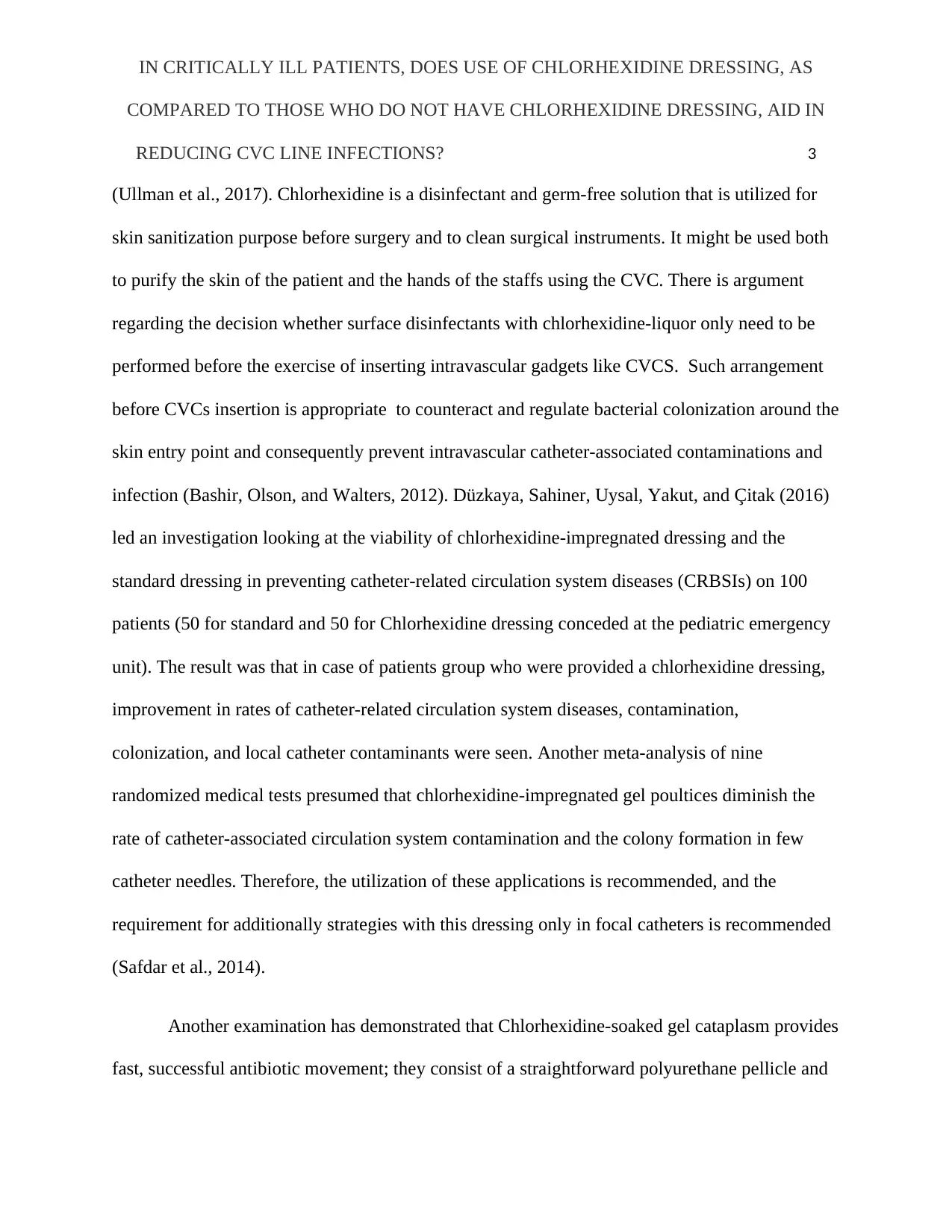
IN CRITICALLY ILL PATIENTS, DOES USE OF CHLORHEXIDINE DRESSING, AS
COMPARED TO THOSE WHO DO NOT HAVE CHLORHEXIDINE DRESSING, AID IN
REDUCING CVC LINE INFECTIONS? 3
(Ullman et al., 2017). Chlorhexidine is a disinfectant and germ-free solution that is utilized for
skin sanitization purpose before surgery and to clean surgical instruments. It might be used both
to purify the skin of the patient and the hands of the staffs using the CVC. There is argument
regarding the decision whether surface disinfectants with chlorhexidine-liquor only need to be
performed before the exercise of inserting intravascular gadgets like CVCS. Such arrangement
before CVCs insertion is appropriate to counteract and regulate bacterial colonization around the
skin entry point and consequently prevent intravascular catheter-associated contaminations and
infection (Bashir, Olson, and Walters, 2012). Düzkaya, Sahiner, Uysal, Yakut, and Çitak (2016)
led an investigation looking at the viability of chlorhexidine-impregnated dressing and the
standard dressing in preventing catheter-related circulation system diseases (CRBSIs) on 100
patients (50 for standard and 50 for Chlorhexidine dressing conceded at the pediatric emergency
unit). The result was that in case of patients group who were provided a chlorhexidine dressing,
improvement in rates of catheter-related circulation system diseases, contamination,
colonization, and local catheter contaminants were seen. Another meta-analysis of nine
randomized medical tests presumed that chlorhexidine-impregnated gel poultices diminish the
rate of catheter-associated circulation system contamination and the colony formation in few
catheter needles. Therefore, the utilization of these applications is recommended, and the
requirement for additionally strategies with this dressing only in focal catheters is recommended
(Safdar et al., 2014).
Another examination has demonstrated that Chlorhexidine-soaked gel cataplasm provides
fast, successful antibiotic movement; they consist of a straightforward polyurethane pellicle and
COMPARED TO THOSE WHO DO NOT HAVE CHLORHEXIDINE DRESSING, AID IN
REDUCING CVC LINE INFECTIONS? 3
(Ullman et al., 2017). Chlorhexidine is a disinfectant and germ-free solution that is utilized for
skin sanitization purpose before surgery and to clean surgical instruments. It might be used both
to purify the skin of the patient and the hands of the staffs using the CVC. There is argument
regarding the decision whether surface disinfectants with chlorhexidine-liquor only need to be
performed before the exercise of inserting intravascular gadgets like CVCS. Such arrangement
before CVCs insertion is appropriate to counteract and regulate bacterial colonization around the
skin entry point and consequently prevent intravascular catheter-associated contaminations and
infection (Bashir, Olson, and Walters, 2012). Düzkaya, Sahiner, Uysal, Yakut, and Çitak (2016)
led an investigation looking at the viability of chlorhexidine-impregnated dressing and the
standard dressing in preventing catheter-related circulation system diseases (CRBSIs) on 100
patients (50 for standard and 50 for Chlorhexidine dressing conceded at the pediatric emergency
unit). The result was that in case of patients group who were provided a chlorhexidine dressing,
improvement in rates of catheter-related circulation system diseases, contamination,
colonization, and local catheter contaminants were seen. Another meta-analysis of nine
randomized medical tests presumed that chlorhexidine-impregnated gel poultices diminish the
rate of catheter-associated circulation system contamination and the colony formation in few
catheter needles. Therefore, the utilization of these applications is recommended, and the
requirement for additionally strategies with this dressing only in focal catheters is recommended
(Safdar et al., 2014).
Another examination has demonstrated that Chlorhexidine-soaked gel cataplasm provides
fast, successful antibiotic movement; they consist of a straightforward polyurethane pellicle and
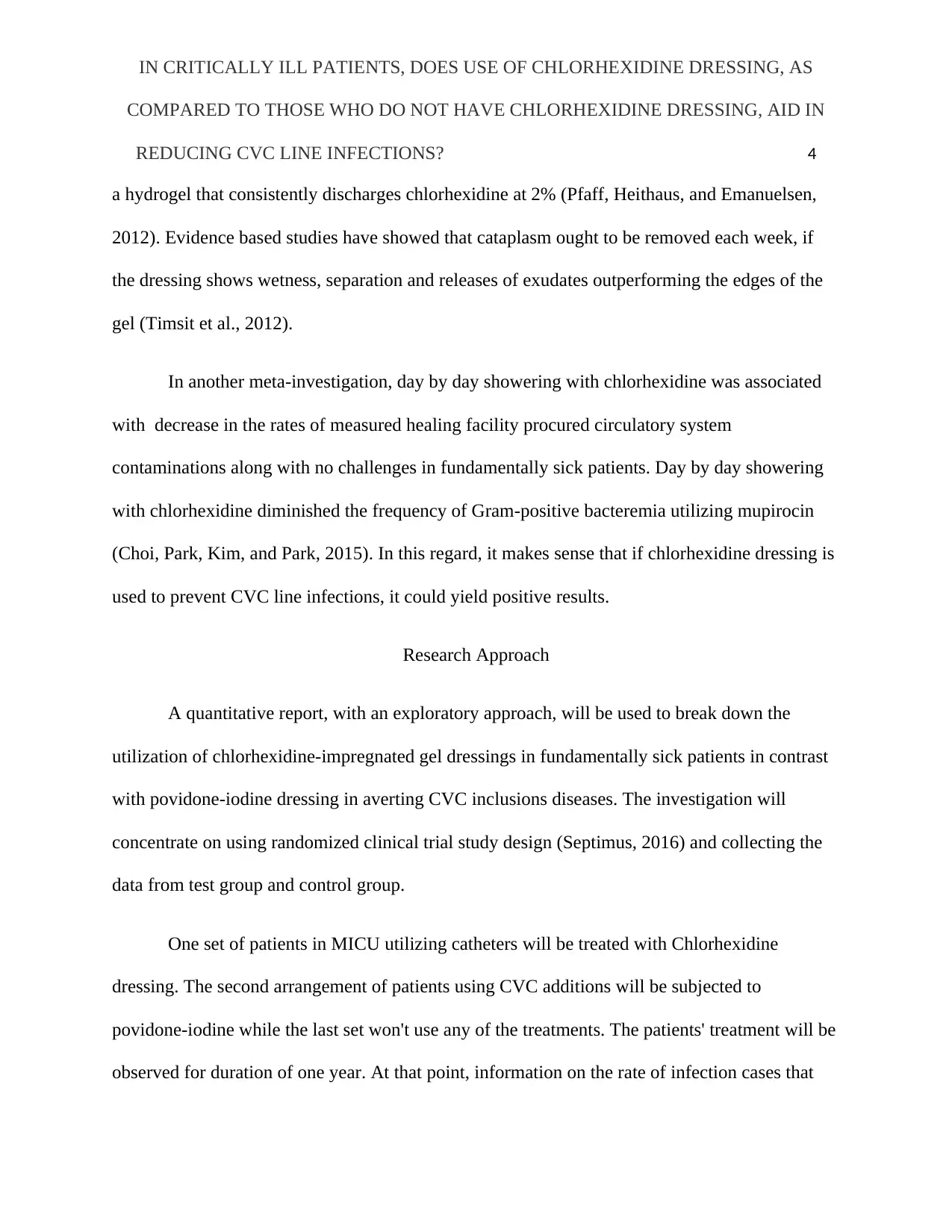
IN CRITICALLY ILL PATIENTS, DOES USE OF CHLORHEXIDINE DRESSING, AS
COMPARED TO THOSE WHO DO NOT HAVE CHLORHEXIDINE DRESSING, AID IN
REDUCING CVC LINE INFECTIONS? 4
a hydrogel that consistently discharges chlorhexidine at 2% (Pfaff, Heithaus, and Emanuelsen,
2012). Evidence based studies have showed that cataplasm ought to be removed each week, if
the dressing shows wetness, separation and releases of exudates outperforming the edges of the
gel (Timsit et al., 2012).
In another meta-investigation, day by day showering with chlorhexidine was associated
with decrease in the rates of measured healing facility procured circulatory system
contaminations along with no challenges in fundamentally sick patients. Day by day showering
with chlorhexidine diminished the frequency of Gram-positive bacteremia utilizing mupirocin
(Choi, Park, Kim, and Park, 2015). In this regard, it makes sense that if chlorhexidine dressing is
used to prevent CVC line infections, it could yield positive results.
Research Approach
A quantitative report, with an exploratory approach, will be used to break down the
utilization of chlorhexidine-impregnated gel dressings in fundamentally sick patients in contrast
with povidone-iodine dressing in averting CVC inclusions diseases. The investigation will
concentrate on using randomized clinical trial study design (Septimus, 2016) and collecting the
data from test group and control group.
One set of patients in MICU utilizing catheters will be treated with Chlorhexidine
dressing. The second arrangement of patients using CVC additions will be subjected to
povidone-iodine while the last set won't use any of the treatments. The patients' treatment will be
observed for duration of one year. At that point, information on the rate of infection cases that
COMPARED TO THOSE WHO DO NOT HAVE CHLORHEXIDINE DRESSING, AID IN
REDUCING CVC LINE INFECTIONS? 4
a hydrogel that consistently discharges chlorhexidine at 2% (Pfaff, Heithaus, and Emanuelsen,
2012). Evidence based studies have showed that cataplasm ought to be removed each week, if
the dressing shows wetness, separation and releases of exudates outperforming the edges of the
gel (Timsit et al., 2012).
In another meta-investigation, day by day showering with chlorhexidine was associated
with decrease in the rates of measured healing facility procured circulatory system
contaminations along with no challenges in fundamentally sick patients. Day by day showering
with chlorhexidine diminished the frequency of Gram-positive bacteremia utilizing mupirocin
(Choi, Park, Kim, and Park, 2015). In this regard, it makes sense that if chlorhexidine dressing is
used to prevent CVC line infections, it could yield positive results.
Research Approach
A quantitative report, with an exploratory approach, will be used to break down the
utilization of chlorhexidine-impregnated gel dressings in fundamentally sick patients in contrast
with povidone-iodine dressing in averting CVC inclusions diseases. The investigation will
concentrate on using randomized clinical trial study design (Septimus, 2016) and collecting the
data from test group and control group.
One set of patients in MICU utilizing catheters will be treated with Chlorhexidine
dressing. The second arrangement of patients using CVC additions will be subjected to
povidone-iodine while the last set won't use any of the treatments. The patients' treatment will be
observed for duration of one year. At that point, information on the rate of infection cases that
Secure Best Marks with AI Grader
Need help grading? Try our AI Grader for instant feedback on your assignments.

IN CRITICALLY ILL PATIENTS, DOES USE OF CHLORHEXIDINE DRESSING, AS
COMPARED TO THOSE WHO DO NOT HAVE CHLORHEXIDINE DRESSING, AID IN
REDUCING CVC LINE INFECTIONS? 5
would get a disease because of CVC addition will be collected and categorized on the basis of
severity.
This method of conducting research and collecting research data will give proper
information related to outcome in three sample groups. On analysis of the research data, the
information can be utilized to find out whether chlorhexidine counteracts CVC line disease and
how it differs from other disinfectant.
Exploratory research is the excellent approach for attaining causal inferences, concerning
interventions or medication. This is mostly because major emphasis is on analyzing the impact of
certain outcome. If other elements are regulated, the specialist can mention with the assurance
that independent control variable caused a change in the reliant entity (Tashakkori and Teddlie,
2012). The exploration enables the analyst to weigh and categorize data. The connection between
an independent and dependent variable is examined in depth. This is worthwhile since the
analyst is more accurate about the outcomes of the study. Quantitative exploration can be
employed to test the theories in research due to its capacity to quantify data using measurements.
Likewise, this study configuration is repeatable, and in this way, results can be checked and
confirmed. Hence, this research design is most suitable for getting the desired outcome from the
study.
The challenge in the process is that appropriate sample must be selected that is
representative of the whole target population; the bigger the sample size, the more is the chance
of getting valid data. However, conducting research with large sample size is both time
consuming and costly process.
COMPARED TO THOSE WHO DO NOT HAVE CHLORHEXIDINE DRESSING, AID IN
REDUCING CVC LINE INFECTIONS? 5
would get a disease because of CVC addition will be collected and categorized on the basis of
severity.
This method of conducting research and collecting research data will give proper
information related to outcome in three sample groups. On analysis of the research data, the
information can be utilized to find out whether chlorhexidine counteracts CVC line disease and
how it differs from other disinfectant.
Exploratory research is the excellent approach for attaining causal inferences, concerning
interventions or medication. This is mostly because major emphasis is on analyzing the impact of
certain outcome. If other elements are regulated, the specialist can mention with the assurance
that independent control variable caused a change in the reliant entity (Tashakkori and Teddlie,
2012). The exploration enables the analyst to weigh and categorize data. The connection between
an independent and dependent variable is examined in depth. This is worthwhile since the
analyst is more accurate about the outcomes of the study. Quantitative exploration can be
employed to test the theories in research due to its capacity to quantify data using measurements.
Likewise, this study configuration is repeatable, and in this way, results can be checked and
confirmed. Hence, this research design is most suitable for getting the desired outcome from the
study.
The challenge in the process is that appropriate sample must be selected that is
representative of the whole target population; the bigger the sample size, the more is the chance
of getting valid data. However, conducting research with large sample size is both time
consuming and costly process.
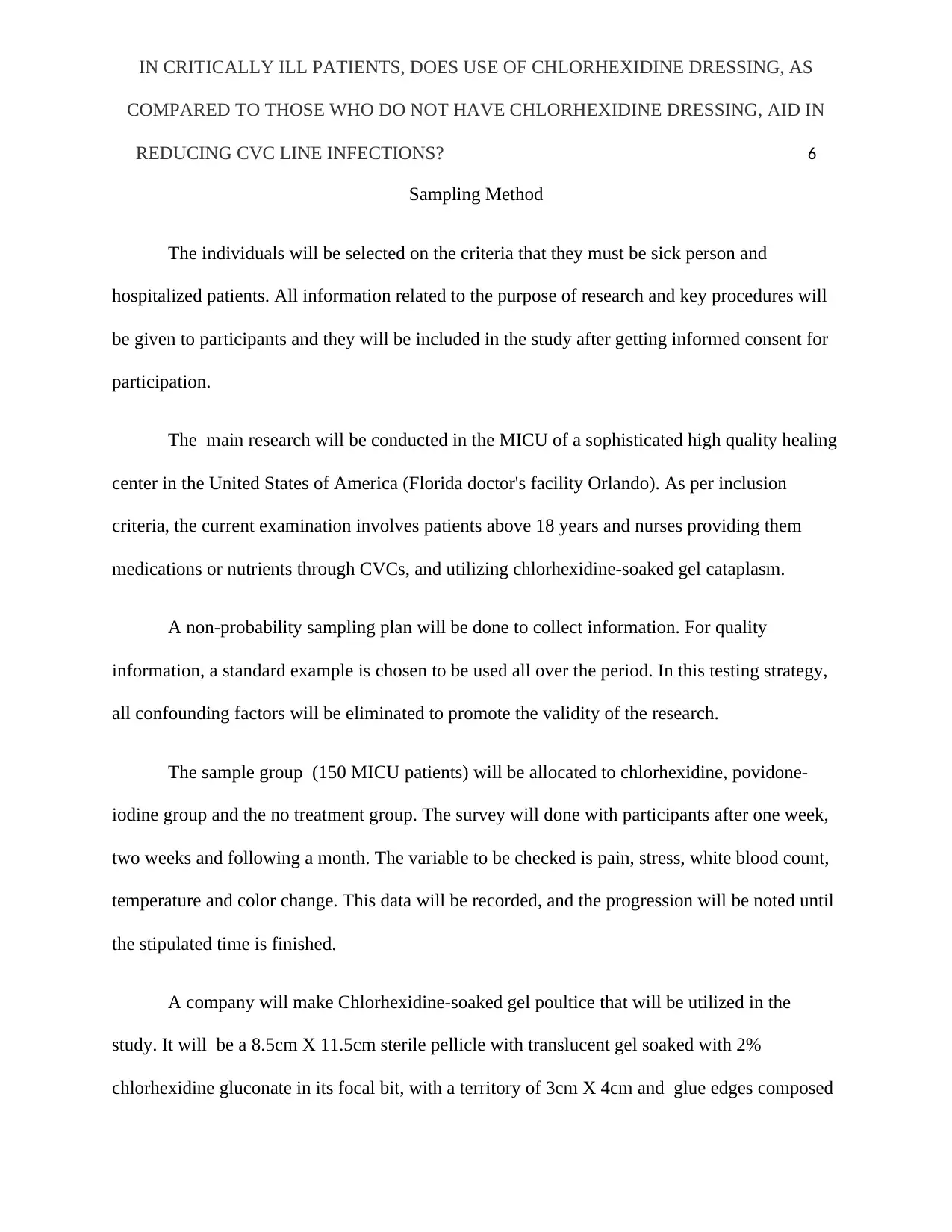
IN CRITICALLY ILL PATIENTS, DOES USE OF CHLORHEXIDINE DRESSING, AS
COMPARED TO THOSE WHO DO NOT HAVE CHLORHEXIDINE DRESSING, AID IN
REDUCING CVC LINE INFECTIONS? 6
Sampling Method
The individuals will be selected on the criteria that they must be sick person and
hospitalized patients. All information related to the purpose of research and key procedures will
be given to participants and they will be included in the study after getting informed consent for
participation.
The main research will be conducted in the MICU of a sophisticated high quality healing
center in the United States of America (Florida doctor's facility Orlando). As per inclusion
criteria, the current examination involves patients above 18 years and nurses providing them
medications or nutrients through CVCs, and utilizing chlorhexidine-soaked gel cataplasm.
A non-probability sampling plan will be done to collect information. For quality
information, a standard example is chosen to be used all over the period. In this testing strategy,
all confounding factors will be eliminated to promote the validity of the research.
The sample group (150 MICU patients) will be allocated to chlorhexidine, povidone-
iodine group and the no treatment group. The survey will done with participants after one week,
two weeks and following a month. The variable to be checked is pain, stress, white blood count,
temperature and color change. This data will be recorded, and the progression will be noted until
the stipulated time is finished.
A company will make Chlorhexidine-soaked gel poultice that will be utilized in the
study. It will be a 8.5cm X 11.5cm sterile pellicle with translucent gel soaked with 2%
chlorhexidine gluconate in its focal bit, with a territory of 3cm X 4cm and glue edges composed
COMPARED TO THOSE WHO DO NOT HAVE CHLORHEXIDINE DRESSING, AID IN
REDUCING CVC LINE INFECTIONS? 6
Sampling Method
The individuals will be selected on the criteria that they must be sick person and
hospitalized patients. All information related to the purpose of research and key procedures will
be given to participants and they will be included in the study after getting informed consent for
participation.
The main research will be conducted in the MICU of a sophisticated high quality healing
center in the United States of America (Florida doctor's facility Orlando). As per inclusion
criteria, the current examination involves patients above 18 years and nurses providing them
medications or nutrients through CVCs, and utilizing chlorhexidine-soaked gel cataplasm.
A non-probability sampling plan will be done to collect information. For quality
information, a standard example is chosen to be used all over the period. In this testing strategy,
all confounding factors will be eliminated to promote the validity of the research.
The sample group (150 MICU patients) will be allocated to chlorhexidine, povidone-
iodine group and the no treatment group. The survey will done with participants after one week,
two weeks and following a month. The variable to be checked is pain, stress, white blood count,
temperature and color change. This data will be recorded, and the progression will be noted until
the stipulated time is finished.
A company will make Chlorhexidine-soaked gel poultice that will be utilized in the
study. It will be a 8.5cm X 11.5cm sterile pellicle with translucent gel soaked with 2%
chlorhexidine gluconate in its focal bit, with a territory of 3cm X 4cm and glue edges composed
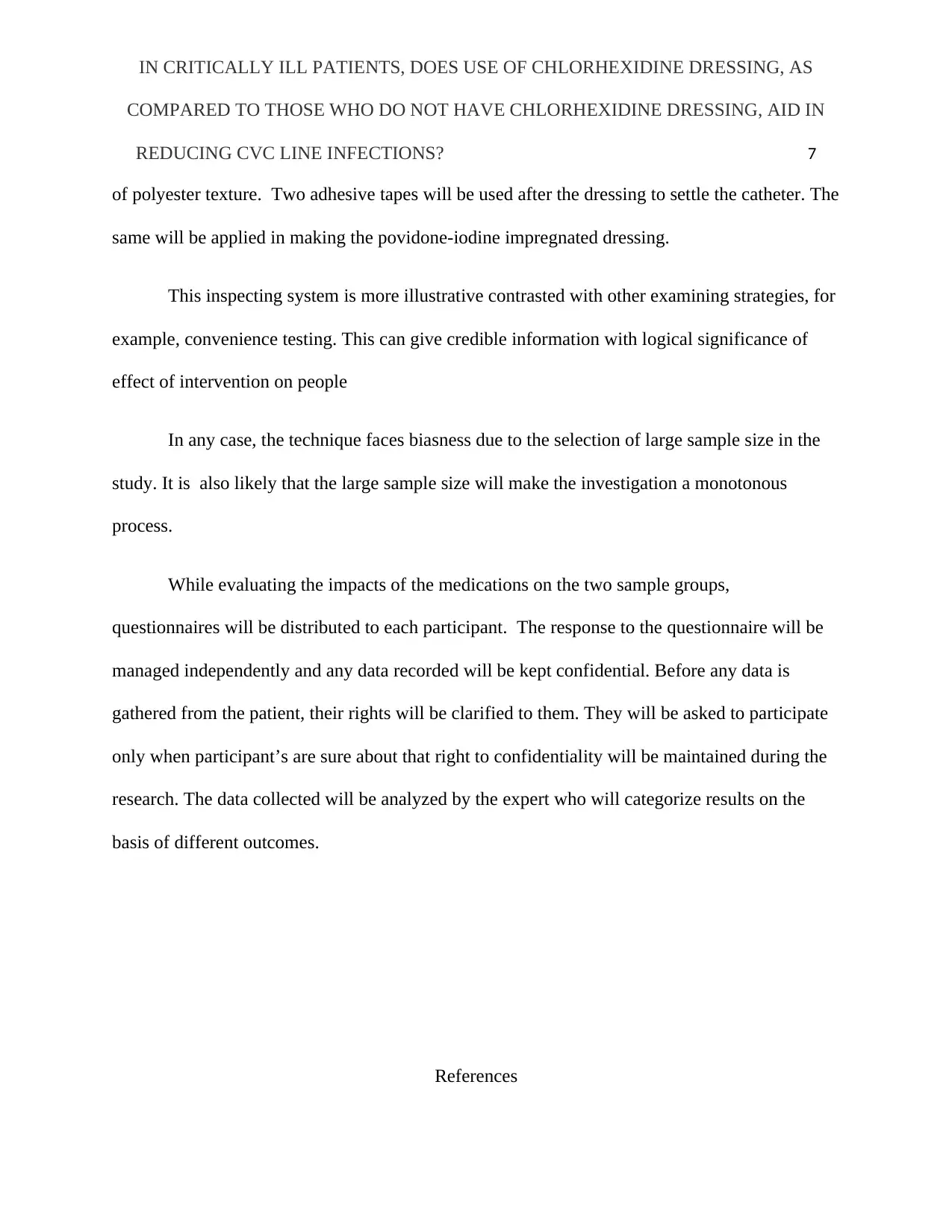
IN CRITICALLY ILL PATIENTS, DOES USE OF CHLORHEXIDINE DRESSING, AS
COMPARED TO THOSE WHO DO NOT HAVE CHLORHEXIDINE DRESSING, AID IN
REDUCING CVC LINE INFECTIONS? 7
of polyester texture. Two adhesive tapes will be used after the dressing to settle the catheter. The
same will be applied in making the povidone-iodine impregnated dressing.
This inspecting system is more illustrative contrasted with other examining strategies, for
example, convenience testing. This can give credible information with logical significance of
effect of intervention on people
In any case, the technique faces biasness due to the selection of large sample size in the
study. It is also likely that the large sample size will make the investigation a monotonous
process.
While evaluating the impacts of the medications on the two sample groups,
questionnaires will be distributed to each participant. The response to the questionnaire will be
managed independently and any data recorded will be kept confidential. Before any data is
gathered from the patient, their rights will be clarified to them. They will be asked to participate
only when participant’s are sure about that right to confidentiality will be maintained during the
research. The data collected will be analyzed by the expert who will categorize results on the
basis of different outcomes.
References
COMPARED TO THOSE WHO DO NOT HAVE CHLORHEXIDINE DRESSING, AID IN
REDUCING CVC LINE INFECTIONS? 7
of polyester texture. Two adhesive tapes will be used after the dressing to settle the catheter. The
same will be applied in making the povidone-iodine impregnated dressing.
This inspecting system is more illustrative contrasted with other examining strategies, for
example, convenience testing. This can give credible information with logical significance of
effect of intervention on people
In any case, the technique faces biasness due to the selection of large sample size in the
study. It is also likely that the large sample size will make the investigation a monotonous
process.
While evaluating the impacts of the medications on the two sample groups,
questionnaires will be distributed to each participant. The response to the questionnaire will be
managed independently and any data recorded will be kept confidential. Before any data is
gathered from the patient, their rights will be clarified to them. They will be asked to participate
only when participant’s are sure about that right to confidentiality will be maintained during the
research. The data collected will be analyzed by the expert who will categorize results on the
basis of different outcomes.
References
Paraphrase This Document
Need a fresh take? Get an instant paraphrase of this document with our AI Paraphraser

IN CRITICALLY ILL PATIENTS, DOES USE OF CHLORHEXIDINE DRESSING, AS
COMPARED TO THOSE WHO DO NOT HAVE CHLORHEXIDINE DRESSING, AID IN
REDUCING CVC LINE INFECTIONS? 8
Bashir, M. H., Olson, L. K., & Walters, S. (2012). Suppression of regrowth of normal skin flora
under chlorhexidine gluconate dressings applied to chlorhexidine gluconate-prepped skin.
American Journal of Infection Control, 40(4), 344-348. doi:10.1016/j.ajic.2011.03.030
Choi, E. Y., Park, D., Kim, H. J., & Park, J. (2015). Efficacy of chlorhexidine bathing for
reducing healthcare associated bloodstream infections: a meta-analysis. Annals of
Intensive Care, 5(1). doi:10.1186/s13613-015-0073-9
Düzkaya, D. S., Sahiner, N. C., Uysal, G., Yakut, T., & Çitak, A. (2016). Chlorhexidine-
Impregnated Dressings and Prevention of Catheter-Associated Bloodstream Infections in
a Pediatric Intensive Care Unit. Critical care nurse, 36(6), e1-e7.
Gavin, N. C., Webster, J., Chan, R. J., & Rickard, C. M. (2016). Frequency of dressing changes
for central venous access devices on catheter‐related infections. The Cochrane Library.
Nogueira, L. D., Koike, K. M., Sardinha, D. S., Padilha, K. G., & Sousa, R. M. (2013). Nursing
workload in public and private intensive care units. Revista Brasileira de Terapia
Intensiva, 25(3), 225-232. doi:10.5935/0103-507x.20130039
Pfaff, B., Heithaus, T., & Emanuelsen, M. (2012). Use of a 1-Piece Chlorhexidine Gluconate
Transparent Dressing on Critically Ill Patients. Critical Care Nurse, 32(4), 35-40.
doi:10.4037/ccn2012956
Safdar, N., O'Horo, J. C., Ghufran, A., Bearden, A., Didier, M. E., Chateau, D., & Maki, D. G.
(2014). Chlorhexidine-Impregnated Dressing for Prevention of Catheter-Related
COMPARED TO THOSE WHO DO NOT HAVE CHLORHEXIDINE DRESSING, AID IN
REDUCING CVC LINE INFECTIONS? 8
Bashir, M. H., Olson, L. K., & Walters, S. (2012). Suppression of regrowth of normal skin flora
under chlorhexidine gluconate dressings applied to chlorhexidine gluconate-prepped skin.
American Journal of Infection Control, 40(4), 344-348. doi:10.1016/j.ajic.2011.03.030
Choi, E. Y., Park, D., Kim, H. J., & Park, J. (2015). Efficacy of chlorhexidine bathing for
reducing healthcare associated bloodstream infections: a meta-analysis. Annals of
Intensive Care, 5(1). doi:10.1186/s13613-015-0073-9
Düzkaya, D. S., Sahiner, N. C., Uysal, G., Yakut, T., & Çitak, A. (2016). Chlorhexidine-
Impregnated Dressings and Prevention of Catheter-Associated Bloodstream Infections in
a Pediatric Intensive Care Unit. Critical care nurse, 36(6), e1-e7.
Gavin, N. C., Webster, J., Chan, R. J., & Rickard, C. M. (2016). Frequency of dressing changes
for central venous access devices on catheter‐related infections. The Cochrane Library.
Nogueira, L. D., Koike, K. M., Sardinha, D. S., Padilha, K. G., & Sousa, R. M. (2013). Nursing
workload in public and private intensive care units. Revista Brasileira de Terapia
Intensiva, 25(3), 225-232. doi:10.5935/0103-507x.20130039
Pfaff, B., Heithaus, T., & Emanuelsen, M. (2012). Use of a 1-Piece Chlorhexidine Gluconate
Transparent Dressing on Critically Ill Patients. Critical Care Nurse, 32(4), 35-40.
doi:10.4037/ccn2012956
Safdar, N., O'Horo, J. C., Ghufran, A., Bearden, A., Didier, M. E., Chateau, D., & Maki, D. G.
(2014). Chlorhexidine-Impregnated Dressing for Prevention of Catheter-Related

IN CRITICALLY ILL PATIENTS, DOES USE OF CHLORHEXIDINE DRESSING, AS
COMPARED TO THOSE WHO DO NOT HAVE CHLORHEXIDINE DRESSING, AID IN
REDUCING CVC LINE INFECTIONS? 9
Bloodstream Infection. Critical Care Medicine, 42(7), 1703-1713.
doi:10.1097/ccm.0000000000000319
Septimus, E. J. (2016). Faculty of 1000 evaluation for Chlorhexidine-impregnated sponges and
less frequent dressing changes for prevention of catheter-related infections in critically ill
adults: a randomized controlled trial. F1000 - Post-publication peer review of the
biomedical literature. doi:10.3410/f.1166053.793513076
Tashakkori, A., & Teddlie, C. (2012). Integrating Qualitative and Quantitative Approaches to
Research. The SAGE Handbook of Applied Social Research Methods, 283-317.
doi:10.4135/9781483348858.n9
Timsit, J., Mimoz, O., Mourvillier, B., Souweine, B., Garrouste-Orgeas, M., Alfandari, S., …
Lucet, J. (2012). Randomized Controlled Trial of Chlorhexidine Dressing and Highly
Adhesive Dressing for Preventing Catheter-related Infections in Critically Ill Adults.
American Journal of Respiratory and Critical Care Medicine, 186(12), 1272-1278.
doi:10.1164/rccm.201206-1038oc
Ullman, A. J., Kleidon, T., Gibson, V., McBride, C. A., Mihala, G., Cooke, M., & Rickard, C.
M. (2017). Innovative dressing and securement of tunneled central venous access devices
in pediatrics: a pilot randomized controlled trial. BMC Cancer, 17, 595.
http://doi.org/10.1186/s12885-017-3606-9
Ullman, A. J., Cooke, M. L., Mitchell, M., Lin, F., New, K., Long, D. A., … Rickard, C. M.
(2016). Dressing and securement for central venous access devices (CVADs): A
COMPARED TO THOSE WHO DO NOT HAVE CHLORHEXIDINE DRESSING, AID IN
REDUCING CVC LINE INFECTIONS? 9
Bloodstream Infection. Critical Care Medicine, 42(7), 1703-1713.
doi:10.1097/ccm.0000000000000319
Septimus, E. J. (2016). Faculty of 1000 evaluation for Chlorhexidine-impregnated sponges and
less frequent dressing changes for prevention of catheter-related infections in critically ill
adults: a randomized controlled trial. F1000 - Post-publication peer review of the
biomedical literature. doi:10.3410/f.1166053.793513076
Tashakkori, A., & Teddlie, C. (2012). Integrating Qualitative and Quantitative Approaches to
Research. The SAGE Handbook of Applied Social Research Methods, 283-317.
doi:10.4135/9781483348858.n9
Timsit, J., Mimoz, O., Mourvillier, B., Souweine, B., Garrouste-Orgeas, M., Alfandari, S., …
Lucet, J. (2012). Randomized Controlled Trial of Chlorhexidine Dressing and Highly
Adhesive Dressing for Preventing Catheter-related Infections in Critically Ill Adults.
American Journal of Respiratory and Critical Care Medicine, 186(12), 1272-1278.
doi:10.1164/rccm.201206-1038oc
Ullman, A. J., Kleidon, T., Gibson, V., McBride, C. A., Mihala, G., Cooke, M., & Rickard, C.
M. (2017). Innovative dressing and securement of tunneled central venous access devices
in pediatrics: a pilot randomized controlled trial. BMC Cancer, 17, 595.
http://doi.org/10.1186/s12885-017-3606-9
Ullman, A. J., Cooke, M. L., Mitchell, M., Lin, F., New, K., Long, D. A., … Rickard, C. M.
(2016). Dressing and securement for central venous access devices (CVADs): A
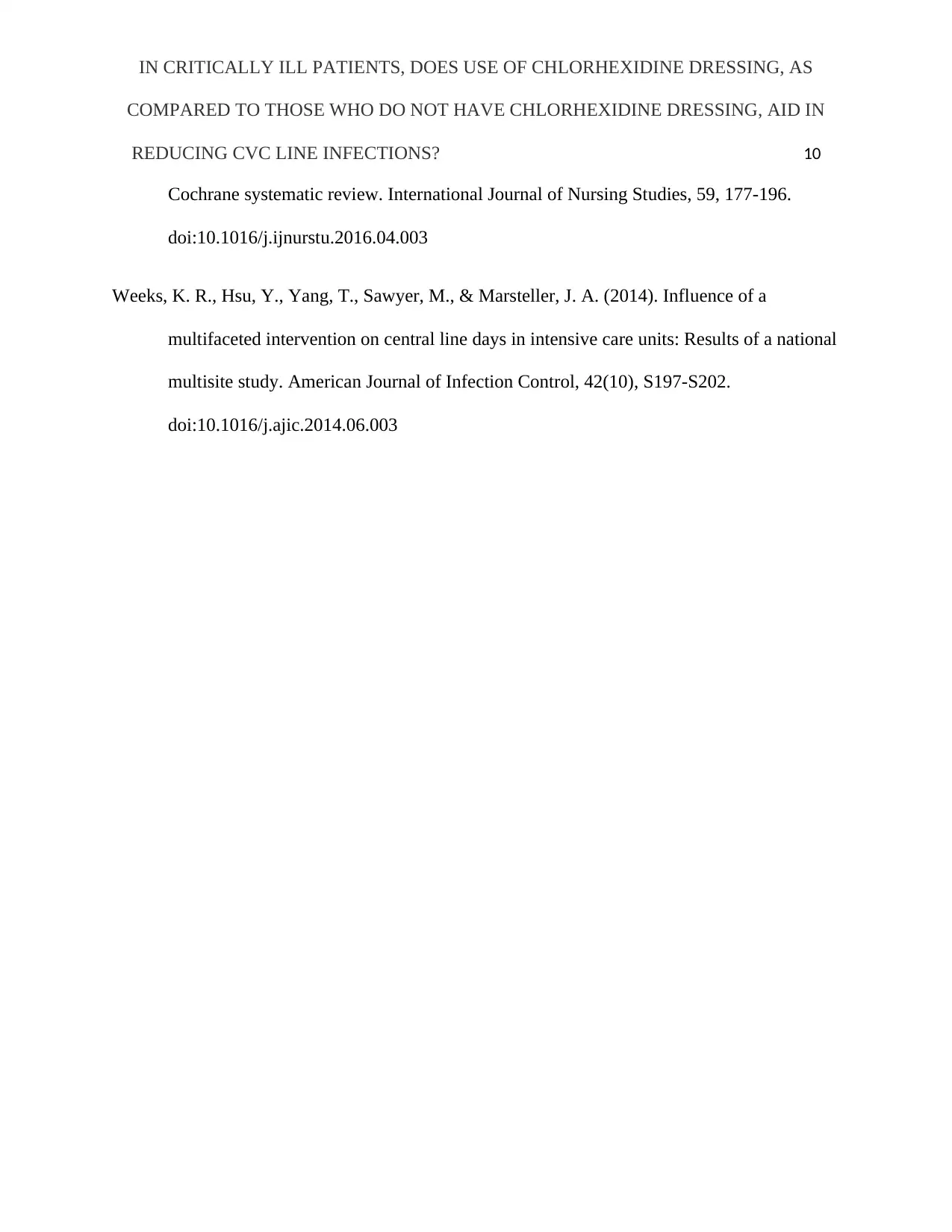
IN CRITICALLY ILL PATIENTS, DOES USE OF CHLORHEXIDINE DRESSING, AS
COMPARED TO THOSE WHO DO NOT HAVE CHLORHEXIDINE DRESSING, AID IN
REDUCING CVC LINE INFECTIONS? 10
Cochrane systematic review. International Journal of Nursing Studies, 59, 177-196.
doi:10.1016/j.ijnurstu.2016.04.003
Weeks, K. R., Hsu, Y., Yang, T., Sawyer, M., & Marsteller, J. A. (2014). Influence of a
multifaceted intervention on central line days in intensive care units: Results of a national
multisite study. American Journal of Infection Control, 42(10), S197-S202.
doi:10.1016/j.ajic.2014.06.003
COMPARED TO THOSE WHO DO NOT HAVE CHLORHEXIDINE DRESSING, AID IN
REDUCING CVC LINE INFECTIONS? 10
Cochrane systematic review. International Journal of Nursing Studies, 59, 177-196.
doi:10.1016/j.ijnurstu.2016.04.003
Weeks, K. R., Hsu, Y., Yang, T., Sawyer, M., & Marsteller, J. A. (2014). Influence of a
multifaceted intervention on central line days in intensive care units: Results of a national
multisite study. American Journal of Infection Control, 42(10), S197-S202.
doi:10.1016/j.ajic.2014.06.003
1 out of 10
Your All-in-One AI-Powered Toolkit for Academic Success.
+13062052269
info@desklib.com
Available 24*7 on WhatsApp / Email
![[object Object]](/_next/static/media/star-bottom.7253800d.svg)
Unlock your academic potential
© 2024 | Zucol Services PVT LTD | All rights reserved.



